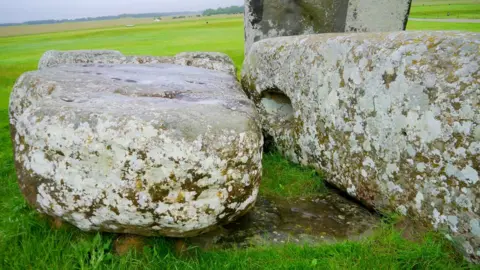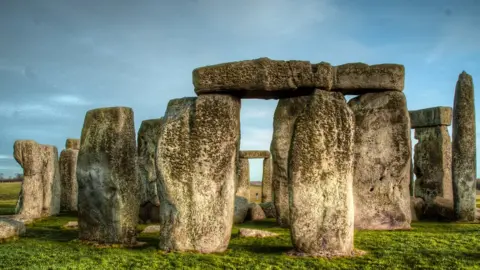Stonehenge's Altar Stone is not Welsh, Aberystwyth University says
 Aberystwyth University
Aberystwyth UniversityThe largest "bluestone" at the heart of Stonehenge may not be from Wales, according to new research.
The Altar Stone was believed to be from old red sandstone in south Wales - rocks that extend in the east across Britain.
This was assumed to be near the Preseli hills, in Pembrokeshire, where most of Stonehenge's bluestones come from.
Aberystwyth University researchers now say its origins could be from northern parts of the UK.
The six-tonne Altar Stone had traditionally been grouped with the other, smaller, igneous bluestones, although when it arrived at Stonehenge is unclear.
The bluestones are believed to have been among the first erected at the Wiltshire site about 5,000 years ago.
Now Aberystwyth scientists have compared analysis of the Altar Stone with 58 samples of old red sandstone from across Wales and the Welsh borders.
They found the Altar Stone's composition could not be matched with any of these locations.
According to the researchers the Altar Stone contains a lot of barium - a kind of metal.
The university said this was unusual and could help reveal its source.
Professor Nick Pearce said: "The conclusions we've drawn from this is that the Altar Stone doesn't come from Wales.
 Getty Images
Getty Images"Perhaps we should also now remove the Altar Stone from the broad grouping of bluestones and consider it independently.
"For the last 100 years the Stonehenge Altar Stone has been considered to have been derived from the old red sandstone sequences of south Wales, in the Anglo-Welsh basin, although no specific location was identified.
"The altar stone appears not, in fact, to come from the old red sandstone of the Anglo-Welsh basin - it is not from south Wales."
He said attention could now turn to areas like northern England and Scotland to try and find its origin.
The research was published in the Journal of Archaeological Science: Reports.

- PARANORMAL: Chilling ghost stories and words appearing on the walls...
- STEELTOWN MURDERS: Three murders - unsolved but never forgotten

